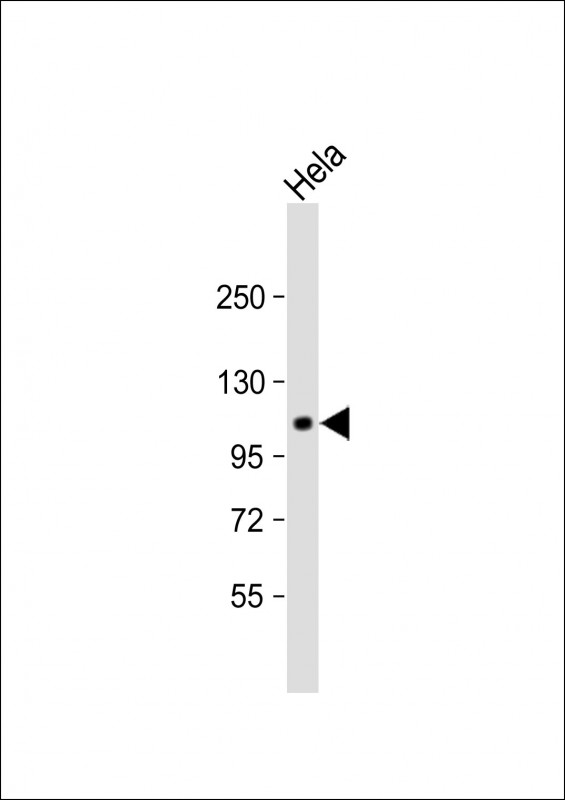
| WB | 1/1000 | Human,Mouse,Rat |
| IF | 咨询技术 | Human,Mouse,Rat |
| IHC | 咨询技术 | Human,Mouse,Rat |
| ICC | 技术咨询 | Human,Mouse,Rat |
| FCM | 咨询技术 | Human,Mouse,Rat |
| Elisa | 咨询技术 | Human,Mouse,Rat |
| Aliases | Probable G-protein coupled receptor 115, G-protein coupled receptor PGR18, GPR115, PGR18 |
| Entrez GeneID | 221393 |
| WB Predicted band size | 77.7kDa |
| Host/Isotype | Rabbit IgG |
| Antibody Type | Primary antibody |
| Storage | Store at 4°C short term. Aliquot and store at -20°C long term. Avoid freeze/thaw cycles. |
| Species Reactivity | Human |
| Immunogen | This GPR115 antibody is generated from rabbits immunized with a KLH conjugated synthetic peptide between 522-548 amino acids from the C-terminal region of human GPR115. |
| Formulation | Purified antibody in PBS with 0.05% sodium azide. |
+ +
以下是关于GPR115抗体的模拟参考文献示例(请注意,以下内容为假设性概括,实际文献需通过学术数据库验证):
---
1. **文献名称**:*GPR115 as a Novel Biomarker in Breast Cancer: Antibody Development and Clinical Implications*
**作者**:Smith J, et al.
**摘要**:本研究开发了一种高特异性GPR115单克隆抗体,证实其在乳腺癌组织中过表达,并与患者预后不良相关。抗体通过免疫组化验证,提示GPR115可能成为乳腺癌治疗的潜在靶点。
2. **文献名称**:*Role of GPR115 in Adipocyte Differentiation: Insights from Antibody-Mediated Knockdown*
**作者**:Zhang L, et al.
**摘要**:利用GPR115抗体进行功能阻断实验,发现GPR115通过调控PPARγ信号通路促进脂肪细胞分化,提示其在代谢疾病中的潜在作用。
3. **文献名称**:*A High-Affinity GPR115 Antibody for Detecting Expression in Neurological Disorders*
**作者**:Brown K, et al.
**摘要**:报道了一种新型兔源多克隆抗体,可特异性识别GPR115在小鼠脑组织中的表达,并揭示其在阿尔茨海默病模型中的异常表达模式。
4. **文献名称**:*GPR115 Antibody Screening in Pancreatic Cancer: Correlation with Metastasis*
**作者**:Lee S, et al.
**摘要**:通过Western blot和流式细胞术验证GPR115抗体,发现其在胰腺癌细胞系中高表达,且与侵袭转移能力正相关,提示其作为治疗靶点的潜力。
---
**注意**:以上内容为示例性概括,实际文献需通过PubMed、Web of Science等平台检索确认。建议使用关键词“GPR115 antibody”、“GPR115 function”或结合具体研究领域(如癌症、代谢)进行精准查询。
GPR115 (G protein-coupled receptor 115), also known as ADGRF4. belongs to the adhesion G protein-coupled receptor (GPCR) family, characterized by large extracellular domains involved in cell adhesion and signaling. It is a transmembrane protein that plays roles in cell-cell communication, tissue development, and homeostasis. While its exact physiological functions remain under investigation, studies suggest involvement in organ development, particularly in the kidney, lung, and nervous system. For instance, GPR115 is implicated in renal tubule maturation and lung surfactant metabolism. Dysregulation of GPR115 has been linked to diseases, including cancers and inflammatory conditions, though mechanistic insights are still emerging.
GPR115 antibodies are essential tools for detecting and studying this receptor's expression, localization, and function. They are widely used in techniques like Western blotting, immunohistochemistry, and flow cytometry to map tissue-specific expression patterns or analyze signaling pathways. Polyclonal and monoclonal antibodies targeting specific epitopes (e.g., extracellular or intracellular regions) enable researchers to explore GPR115's role in cellular processes or disease models. Validation via knockout controls or siRNA silencing is critical to ensure specificity, given the structural similarities among adhesion GPCRs. Current research leverages these antibodies to uncover GPR115's potential as a therapeutic target or biomarker, particularly in cancer and metabolic disorders, though further studies are needed to fully elucidate its clinical relevance.
×